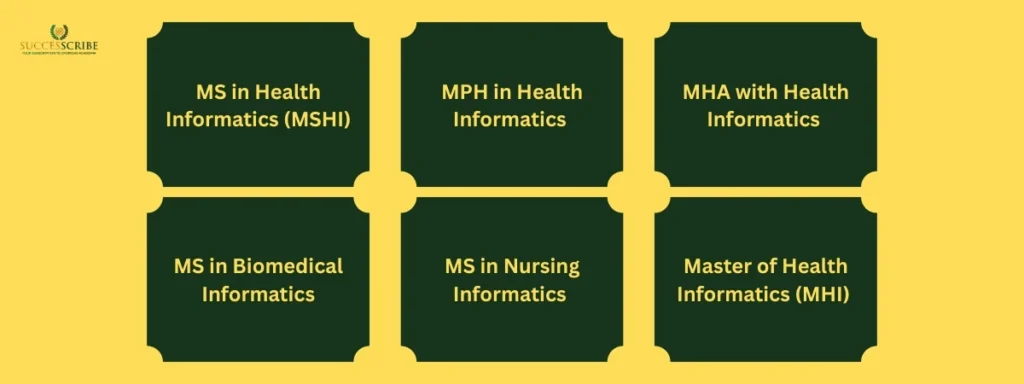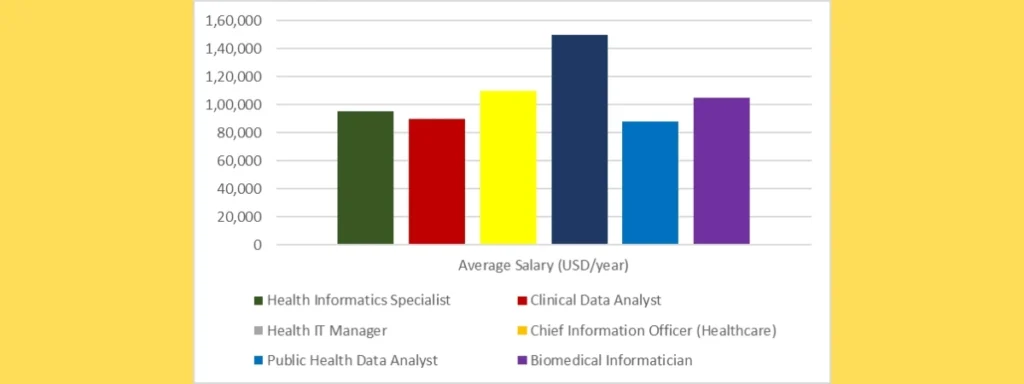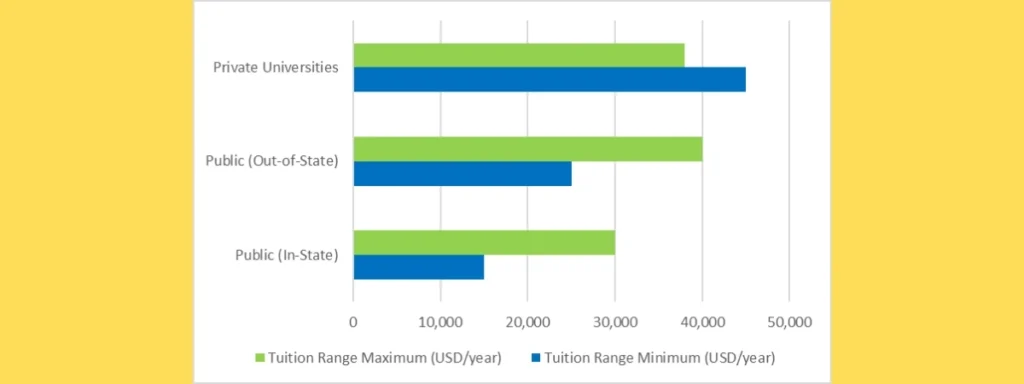As healthcare and technology continue to intersect, Health Informatics is rapidly becoming one of the most in-demand fields in the United States. From managing Electronic Health Records (EHRs) to using artificial intelligence to improve patient outcomes, the role of health informatics professionals is crucial to the future of global healthcare systems.
Why Choose Health Informatics in USA?
According to the U.S. Bureau of Labor Statistics (BLS), employment in medical and health services managers, including health informatics roles, is expected to grow by 28% from 2022 to 2032, much faster than the average for all occupations. The transition to Electronic Health Records (EHRs), the rise of telemedicine, and the growing importance of data-driven healthcare make this field incredibly relevant.
Key Reasons to Pursue Health Informatics:
- High demand and job security
- Competitive salaries (average $100,980 annually)
- Integration of technology and healthcare
- Opportunities in hospitals, insurance, pharma, and government sectors
Industry Demand
| Year | Global Market Value (USD) |
| 2021 | $31.8 Billion |
| 2023 | $42.2 Billion |
| 2025 (projected) | $60.3 Billion |
Types of Health Informatics Degrees in the USA

Health Informatics master’s degrees come with various designations, each with slightly different focus areas:
| Degree Type | Focus |
| MS in Health Informatics (MSHI) | Balanced approach with tech & healthcare |
| Master of Health Informatics (MHI) | Similar to MSHI, sometimes less technical |
| MS in Biomedical Informatics | Research & clinical applications focus |
| MS in Nursing Informatics | For professionals in nursing |
| MPH in Health Informatics | Focus on population health & informatics |
| MHA with Health Informatics | Management and leadership in health tech |
- Master of Science in Health Informatics (MSHI): Comprehensive programs balancing technical skills with healthcare knowledge
- Master of Health Informatics (MHI): Similar to MSHI but sometimes with less technical depth
- Master of Science in Biomedical Informatics: Greater emphasis on clinical applications and research
- Master of Science in Nursing Informatics: Focused on technology applications in nursing practice
- Master of Public Health with Health Informatics Concentration: Combining population health principles with informatics.
- Master of Health Administration with Health Informatics Track: Emphasizing leadership and management aspects.
Top Universities for Health Informatics in USA
The following universities are recognized for their exceptional health informatics master’s programs (based on factors including faculty expertise, curriculum innovation, industry partnerships, and graduate outcomes):
| University | Program Name | Duration | Tuition Fees (Approximate) |
| University of Michigan | MS in Health Informatics | 2 years | $55,000 |
| Harvard University | Master’s in Biomedical Informatics | 1.5-2 years | $65,000 |
| Johns Hopkins University | MS in Health Informatics | 2 years | $60,000 |
| Columbia University | MS in Biomedical Informatics | 2 years | $58,000 |
| University of Washington | MS in Health Informatics & HIM | 2 years | $50,000 |
| University of California, San Diego | MS in Health Informatics | 2 years | $52,000 |
| University of Texas Health Science Center | MS in Biomedical Informatics | 2 years | $45,000 |
Tier 1 Programs (Most Prestigious)

Here are the Tier 1 programs for Masters in Health Informatics in USA:
1. Johns Hopkins University – Master of Science in Applied Health Sciences Informatics
- Location: Baltimore, MD
- Format: On-campus and online options
- Program Length: 18 months (full-time)
- Notable Strength: Integration with Johns Hopkins Medicine, providing exceptional clinical exposure
- 2025 Annual Tuition: $63,750
2. University of Michigan – Master of Health Informatics
- Location: Ann Arbor, MI
- Format: On-campus, hybrid
- Program Length: 2 years
- Notable Strength: Interdisciplinary approach combining School of Information, School of Public Health, and Medical School
- 2025 Annual Tuition: $57,800 (non-resident)
3. Stanford University – MS in Biomedical Informatics
- Location: Stanford, CA
- Format: On-campus
- Program Length: 2 years
- Notable Strength: Cutting-edge AI and machine learning applications in healthcare
- 2025 Annual Tuition: $71,200
4. Harvard University – Master of Medical Sciences in Biomedical Informatics
- Location: Boston, MA
- Format: On-campus
- Program Length: 2 years
- Notable Strength: Access to Harvard’s innovation ecosystem and research facilities
- 2025 Annual Tuition: $65,300
5. Columbia University – Master of Science in Biomedical Informatics
- Location: New York, NY
- Format: On-campus, hybrid
- Program Length: 21 months
- Notable Strength: Strong focus on translational research and precision medicine
- 2025 Annual Tuition: $68,900
Tier 2 Programs (Highly Regarded)
Here are the Tier 2 programs for Masters in Health Inforamtics in USA

6. University of North Carolina at Chapel Hill – Master of Professional Science in Biomedical and Health Informatics
- Location: Chapel Hill, NC
- Format: On-campus, hybrid
- Program Length: 16-20 months
- Notable Strength: Extensive healthcare system partnerships
- 2025 Annual Tuition: $46,200 (non-resident)
7. University of California, San Diego – Master of Advanced Studies in Health Informatics
- Location: San Diego, CA
- Format: Hybrid
- Program Length: 2 years
- Notable Strength: Strong biotech industry connections
- 2025 Annual Tuition: $49,600
8. Northwestern University – Master of Science in Health Informatics
- Location: Chicago, IL
- Format: Online, on-campus
- Program Length: 15 months (accelerated) or 2 years (traditional)
- Notable Strength: Innovation-focused curriculum with entrepreneurship components
- 2025 Annual Tuition: $56,800
9. University of Washington – Master of Science in Biomedical and Health Informatics
- Location: Seattle, WA
- Format: On-campus
- Program Length: 18-24 months
- Notable Strength: Integration with leading research centers
- 2025 Annual Tuition: $51,250 (non-resident)
10. Vanderbilt University – Master of Science in Applied Clinical Informatics
- Location: Nashville, TN
- Format: On-campus, hybrid
- Program Length: 21 months
- Notable Strength: Clinical implementation focus
- 2025 Annual Tuition: $54,400
Also Read: Top medical colleges in USA for Indian students
Affordable Masters in Health Informatics Programs inUSA
For budget-conscious students, these accredited programs offer lower tuition
| University | Program Name | Estimated Tuition (2025) |
| University of Illinois at Chicago | MS in Health Inforamtics | $42,000 |
| Georgia State University | MS in Health Informatics | $40,000 |
| Indiana University | MS in Health Informatics | 38,000(In−state)/45,000 (Out-of-state) |
| University of Central Florida | MS in Health Informatics | 36,000(In−state)/48,000 (Out-of-state) |
Curriculum Structure and Core Components
The Masters in Health Informatics in USA curriculum usually covers topics like clinical decision support, health data analytics, and healthcare IT systems. While specific coursework varies between programs, most Master’s in Health Informatics degrees share common core components:
Foundation Courses
- Health Information Systems Architecture
- Database Design and Data Management in Healthcare
- Healthcare Analytics and Statistics
- Clinical Decision Support Systems
- Healthcare Data Privacy and Security
- Healthcare Policy and Regulatory Environment
- Electronic Health Record Systems
- Project Management in Healthcare IT
- Ethics in Health Information Management
Advanced Technical Courses
- Machine Learning for Healthcare Applications
- Natural Language Processing in Clinical Settings
- Blockchain Applications in Healthcare
- Cloud Computing for Health Data
- Internet of Medical Things (IoMT)
- Health Information Exchange and Interoperability
- Big Data Technologies in Healthcare
Healthcare Domain Knowledge
- Healthcare Organization and Delivery
- Clinical Workflow Analysis
- Population Health Management
- Quality Improvement Methodologies
- Healthcare Economics
- Patient Engagement Technologies
Practical Components
- Capstone Projects: Applied projects addressing real-world healthcare challenges
- Internships: Supervised practical experience in healthcare organizations
- Practicums: Structured field experiences
- Research Projects: Scholarly investigations on specific health informatics topics
Also Read: MBBS in USA without NEET for Indian students
Career Opportunities After Master’s in Health Informatics in USA
Graduates of a Masters in Health Informatics in USA can work as Clinical Data Analysts, Health IT Project Managers, or Healthcare Consultants. Graduates can expect lucrative and meaningful careers in various sectors.
Top Job Roles:
- Health Informatics Specialist
- Clinical Informatics Analyst
- Health Information Manager
- Data Analyst (Healthcare)
- Chief Information Officer (CIO)
- Healthcare IT Project Manager
- Public Health Informatician
Salary Expectations After Master’s in Health Informatics from USA

After completing a Masters in Health Informatics in USA, professionals can expect an average salary between $70,000–$120,000 depending on the role and location.
| Job Role | Average Salary (USD/year) |
| Health Informatics Specialist | $95,000 |
| Clinical Data Analyst | $90,000 |
| Health IT Manager | $110,000 |
| Chief Information Officer (Healthcare) | $150,000+ |
| Public Health Data Analyst | $88,000 |
| Biomedical Informatician | $105,000 |
Tuition Fees for Masters in Health Informatics in USA

The tuition fees for an MHI program in the USA can vary widely depending on whether the university is public or private, and whether the student is an in-state or out-of-state resident. Below is a more detailed breakdown:
| University Type | Tuition Range (USD/year) | Notes |
| Public (In-State) | $15,000 – $30,000 | Lower for state residents |
| Public (Out-of-State) | $25,000 – $40,000 | Higher for non-residents |
| Private Universities | $45,000 – $60,000 | Standard rate for all students |
Beyond tuition, students should budget for their Living Expense while planning to study Masters in Health Informatics in USA:
| Expense Category | Estimated Annual Cost (2025) |
| Health Insurance | 2,500−4,000 |
| Housing (On-Campus) | 12,000−20,000 |
| Housing (Off-Campus) | 10,000−18,000 |
| Transportation | 1,000−3,000 |
| Miscellaneous (Food, Personal) | 5,000−8,000 |
| Books & Software | 1,000−2,000 |
Is the Investment Worth It for Masters in Health Informatics in USA? ROI Analysis
| Metric | Value |
| Average Starting Salary (2025) | 85,000−120,000 |
| Mid-Career Salary (5+ years experience) | 120,000−180,000 |
| Time to Break Even (Tuition vs. Salary) | 3-5 years |
Also Read: Cost of MBBS in USA for Indian students
Scholarships for Master’s students pursuing Health Informatics in USA
Here are the Popular Scholarships for International students pursuing Masters in Health Informatics in USA:
- Fulbright Foreign Student Program (Covers full tuition and living expenses)
- AAUW International Fellowships (Up to $30,000)
- Harvard Global Health Scholarship
- Johns Hopkins Health Informatics Fellowship
- DAAD (for German citizens studying in the U.S.)
Assistantships:
- Graduate Research Assistantships (GRAs)
- Teaching Assistantships (TAs)
- Work-Study Programs
Financial Aid Availability
| University | Avg. Financial Aid for Int’l Students |
| Stanford | $25,000 – $45,000/year |
| Johns Hopkins | $20,000 – $35,000/year |
| Columbia | $30,000/year |
Health Informatics vs. Other Related Fields
As healthcare continues its digital transformation in 2025, several specialized fields have emerged that leverage technology and data to improve healthcare delivery and outcomes. While these disciplines share some common elements, they differ significantly in their focus, methodologies, and career outcomes. Here are the differences between Health Informatics and Other Related Fields:
Health Informatics vs. Public Health

| Aspect | Health Informatics | Public Health |
| Primary Focus | Use of technology and data systems to improve patient care and health outcomes | Improving community health through prevention, education, and policy |
| Tools & Technologies | EHR systems, health data analytics, clinical decision support, telemedicine platforms | Epidemiological software, SAS, SPSS, ArcGIS, public health databases |
| Key Subjects | Clinical informatics, data science, interoperability, health IT | Epidemiology, biostatistics, health policy, community health |
| Typical Job Roles | Health Informatics Specialist, Clinical Data Analyst, Healthcare IT Manager | Epidemiologist, Public Health Analyst, Community Health Manager |
| Work Setting | Hospitals, health tech companies, government health IT departments | Government agencies (CDC, WHO), NGOs, public health departments |
| End Goal | Enhance care delivery using tech and data | Improve population health through policy and outreach |
Health Informatics vs. Bioinformatics

| Aspect | Health Informatics | Bioinformatics |
| Primary Focus | Managing clinical and health-related data to improve care delivery | Analyzing biological/genomic data for research and drug development |
| Tools & Technologies | Health IT systems, SQL, Python, HL7, FHIR | Python, R, Bioconductor, BLAST, GenBank, molecular modeling tools |
| Key Subjects | Health systems, data security, healthcare analytics | Genomics, proteomics, algorithms, data mining in biology |
| Typical Job Roles | Clinical Informatics Analyst, EHR Specialist, Telehealth Manager | Bioinformatics Scientist, Computational Biologist, Genomic Data Analyst |
| Work Setting | Hospitals, healthcare software companies, insurance firms | Research labs, pharma companies, biotech firms, universities |
| End Goal | Better patient outcomes through informed decision-making | Discover biological insights and advance personalized medicine |
Health Informatics vs. Health Information Management (HIM)

| Aspect | Health Informatics | Health Information Management (HIM) |
| Primary Focus | Integration of data, tech, and systems to improve care delivery | Collection, organization, and protection of health records |
| Tools & Technologies | Clinical databases, EHRs, AI/ML in healthcare | Coding systems (ICD-10, CPT), EHRs, RHIA-certified tools |
| Key Subjects | Data analytics, decision support, health IT integration | Medical coding, documentation, health data compliance |
| Typical Job Roles | Health Informatics Analyst, Systems Designer, CIO | Health Information Manager, Medical Records Technician, Coding Auditor |
| Work Setting | Hospitals, tech firms, research institutes | Clinics, hospitals, billing and insurance companies |
| End Goal | Optimize clinical decisions and outcomes using tech | Ensure health records are accurate, secure, and compliant |
Which Field Should You Choose?
2025 Outlook says that Health Informatics offers the highest salaries due to tech demand, while Bioinformatics is growing fastest in biotech/pharma.
- Choose Health Informatics if: You want to work with AI, EHRs, and big data in hospitals or tech firms.
- Choose Public Health if: You prefer policy, epidemiology, and community health programs.
- Choose Bioinformatics if: You’re passionate about genetics, drug development, or lab research.
- Choose HIM if: You enjoy coding, compliance, and managing patient records.
Conclusion
Is a Master’s in Health Informatics in the USA Worth It? Absolutely. With digital transformation driving every aspect of healthcare, the demand for health informatics professionals is skyrocketing. Whether you’re a computer science grad, a nurse looking to specialize, or a healthcare manager upgrading your skills, whether you’re from a healthcare or tech background, a Masters in Health Informatics in USA can transform your career and connect you with global healthcare innovations.
FAQs
“I’m from a non-IT background (e.g., nursing/pharmacy). Can I still get into Health Informatics?
Yes! Many programs prefer clinical professionals transitioning into tech.
Path: Take online courses in SQL, Python, or EHR systems (Epic, Cerner) before applying.
What programming or technical skills should I learn before starting a Health Informatics master’s?
Basic proficiency in SQL, Python, or R is beneficial. Understanding data structures, databases, and Excel analytics can give you a head start. Some universities offer pre-course modules if you’re from a non-technical background.
Can I work while studying for my Master’s in Health Informatics in the USA?
Yes. International students can work on-campus up to 20 hours/week during the semester. Many students also secure Teaching Assistant (TA), Research Assistant (RA), or Graduate Assistant roles in the informatics or public health departments.
Which universities offer the best ROI for Health Informatics degrees?
Public universities like University of Illinois at Chicago, Georgia State University, and Indiana University offer great value with low tuition and strong employment rates. Programs with internships or capstones tend to boost ROI.
Is GRE required for Health Informatics in the USA in 2025?
Mostly no. A growing number of programs have waived the GRE due to its limited predictive value. However, a good GRE score can help in competitive applications or for scholarships at selective schools like Columbia or Stanford.
Related Post
Masters in automotive engineering in USA
Masters in finance in USA
Masters in artificial intelligence in USA
Masters in economics in USA















